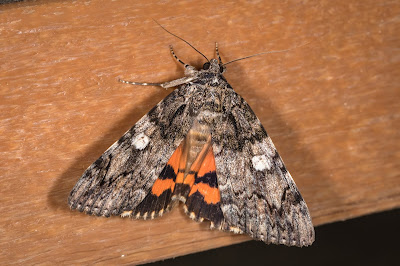 |
| Can you find the underwing moth? |
Commonly known as underwings, the genus Catocala is a large group of moths where most species are somberly clad with brown or gray-shaded forewings, often in variable, cryptic patterns of wavy lines closely resembling tree bark. It is their hindwings, kept hidden at rest, that are typically a vivid orange, red, or yellow, and marked with black bands or stripes.
The genus Catocala comes from the Greek kato meaning ‘rear or lower one’ and kalos meaning ‘beautiful’, together translating to ‘beautiful hindwings.’ Of the more than 100 underwing species found in the United States, 15 or so are known in Travis County, including the Ilia Underwing (Catocala ilia), Little Nymph Underwing (Catocala micronympha), and Ultronia Underwing (Catocala ultronia).
 |
| Ilia Underwing |
The Ilia Underwing, also known as the Beloved Underwing or Wife Underwing, is one of our most common large underwings. It has a total length to 1.8 inches, and gray to brownish forewings with a bold black line above a white or white-outlined spot. The reddish-orange hindwings have two black bands, and a pale orange, checkered fringe. It utilizes oaks for its host plants, especially red oaks such as Shumard’s Oak and Southern Red Oak. Its common and scientific name Ilia likely refers to the mythical mother of the twins Romulus and Remus, who were the mythological founders of the city of Rome.
 |
| Little Nymph Underwing |
One of our smaller underwings with a total length of up to 1 inch, the Little Nymph Underwing has brown to grayish forewings typically marked with a dark, curving, shadow-like crescent. The golden orange hindwings have two black bands, sometimes broken, and a pale, checked fringe. It prefers white oaks as host plants, specifically Post Oak, Bur Oak, and Coastal Live Oak. Its species name comes from the Greek and means ‘little bride or mistress.’
 |
| Ultronia Underwing |
The Ultronia Underwing is medium-sized underwing to 1.3 inches in length, and is identified by its grayish-brown forewings marked with a darker brown shading on the inner edge. The reddish hindwings have two black bands and a mostly gray fringe. Escarpment Black Cherry and Coastal Live Oak are its preferred host plants, and its common and scientific names are said to have come from the name of a Greek island.
It is believed that the bright colors of these moths’ hindwings, which usually form roughly concentric patterns, resemble the eyes of a predatory animal when suddenly flashed toward danger. Underwings are also said to possess fairly well-developed hearing organs, allowing them to evade nocturnal predators such as bats. Their cryptic forewings keep them hidden during the day as they roost on tree bark and in crevices, and even in their larval form their coloring and patterns often mimic gray bark or green lichen. While most active shortly after nightfall, several species have a second activity period for a few hours around noon, when these beautiful hindwings can sometimes be found on the wing in broad daylight!